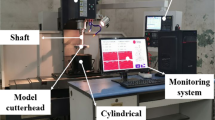Abstract
Wear is one of the most common problems in heavy equipment components. Recently, there were several cases of such problem in different locations in Indonesia. Wear occurred at the bushings on the undercarriage of heavy equipment, which acted as the connector between chains. The events occurred at a high rate, and there are differences in rate for each area of operation. The objective of this research was to understand the wear mechanism of worn bushings and determine the relationship between soil types and wear level. Laboratory characterization of bushing specimens and three-body abrasion test which referred to ASTM B611 were conducted. Characterization of worn specimens involved visual examination, chemical composition characterization, microstructure observation, measurement of phase thickness, hardness test and SEM observation. A three-body abrasion test was carried out using a machine test developed specifically for this study. Wear initiated at the contact area between bushing, sprocket and soil due to friction. The contact produced shear stress and compression stress on the bushing. Due to shear stress exceeding shear strength, the surface of the bushing underwent plastic deformation. Wear resistance test in varying soil types measured the total mass reduction of specimen. The soil types were, in order of highest to lowest mass reduction: plastic soil (75% silica), plastic soil (60% silica), non-plastic soil (80% silica) and non-plastic soil (70% silica). In non-plastic soil type, higher friction speed resulted in a greater mass reduction of specimen. However, in plastic soil, there was no observable connection between speed and mass reduction. Additionally, the mass reduction of specimen in non-plastic soil tended to be linear over time.














Similar content being viewed by others
References
R. Huzij, Modern Diesel Technology 2nd edition, Heavy Equipment System, 2013 (in English)
V. Onishchenko, Investigation of tooth wears from scuffing of heavy duty machine spur gears. Mech. Mach. Theory 83, 38–55 (2015). (in USA)
J. Kelller et al., Influence of chemical composition and microstructure of gray cast iron on wear of heavy duty diesel engine cylinder liners. Wear 263(7–12), 1158–1164 (2017). (in Canada)
V. Onishchenko, Analysis of the abrasive wear mechanism by successive observations of wear process in a scanning electron microscope. Wear 110(3-4), 419–430 (1980)
C. Yunxia, G. Wenjun, K. Rui, Coupling behaviour between adhesive and abrasive wear mechanism of aero-hydraulic spool valves. Chin. J. Aeronaut. 29(4), 1119–1131 (2015). (in China)
R.G. Bayer, Failure Analysis and Prevention, Vol. 11. ASM International
R.F. Craig, Soil Mechanics (CRC Press, Boca Raton, 1989)
J. De garmo, J.T., Black, R.A. Kohser, Materials and Processes in Manufacturing, 10th Ed., 2008 (in USA)
V. Rudnev, G. Totten, Induction Heating and Heat Treatment, Vol. 4C. ASM International
Standard Test Method for Abrasive Wear Resistance of Cemented Carbides, B611. ASTM International
W.D. Callister, D.G. Rethwisch, Materials Science and Engineering An Introduction, 8th Ed., 2010
P. J. Blau, Tribosystem Analysis: A Practical Approach to the Diagnosis of Wear Problems, 1st Ed., 2016
J.D. Gates, G.J. Gore, Wear of metals: philosophies and practicalities. Mater. Forum 19, 53–89 (1995)
K.H. Zum Gahr, Microstructure and Wear of Materials, Tribology Series, Vol 10, 1987 (in Amsterdam)
K.G. Budinski, Friction, Wear, and Erosion Atlas, 1st Ed., 2014
B. Bhushan, Principles and Applications of Tribology, 2nd Ed., 2013
P.J. Blau, Friction, Lubrication, and Wear Technology, ASM Metals Handbook Volume 18. ASM International, 1992
Braja M. Das, Principles of Geotechnical Engineering, 1995
S. Wirojanupatump, P.H. Shipway, Abrasion of mild steel in wet and dry conditions with the rubber and steel wheel abrasion apparatus. Wear 239(1), 91–101 (2000)
Author information
Authors and Affiliations
Corresponding author
Additional information
Publisher's Note
Springer Nature remains neutral with regard to jurisdictional claims in published maps and institutional affiliations.
Rights and permissions
About this article
Cite this article
Pratiwi, I., Ramdan, R., Sasmita, F. et al. The Effect of Soil Type from Indonesian Field on the Wear Mechanism of Undercarriage Component in Heavy Vehicle. J Fail. Anal. and Preven. 20, 1081–1090 (2020). https://doi.org/10.1007/s11668-020-00933-7
Received:
Revised:
Published:
Issue Date:
DOI: https://doi.org/10.1007/s11668-020-00933-7




